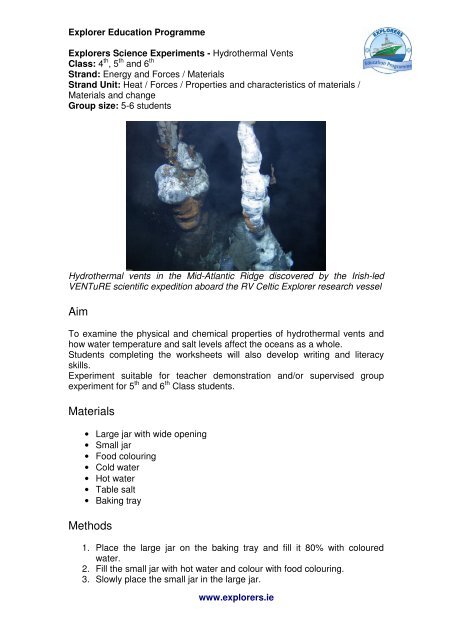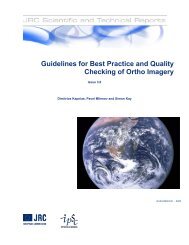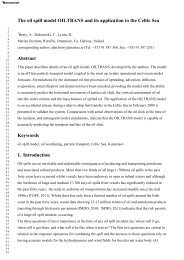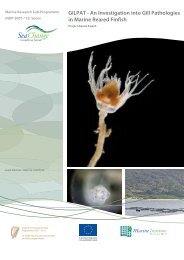Hydrothermal Vents-Experiment & Worksheet.pdf
Hydrothermal Vents-Experiment & Worksheet.pdf
Hydrothermal Vents-Experiment & Worksheet.pdf
Create successful ePaper yourself
Turn your PDF publications into a flip-book with our unique Google optimized e-Paper software.
Explorer Education ProgrammeExplorers Science <strong>Experiment</strong>s - <strong>Hydrothermal</strong> <strong>Vents</strong>Class: 4 th , 5 th and 6 thStrand: Energy and Forces / MaterialsStrand Unit: Heat / Forces / Properties and characteristics of materials /Materials and changeGroup size: 5-6 students<strong>Hydrothermal</strong> vents in the Mid-Atlantic Ridge discovered by the Irish-ledVENTuRE scientific expedition aboard the RV Celtic Explorer research vesselAimTo examine the physical and chemical properties of hydrothermal vents andhow water temperature and salt levels affect the oceans as a whole.Students completing the worksheets will also develop writing and literacyskills.<strong>Experiment</strong> suitable for teacher demonstration and/or supervised groupexperiment for 5 th and 6 th Class students.Materials• Large jar with wide opening• Small jar• Food colouring• Cold water• Hot water• Table salt• Baking trayMethods1. Place the large jar on the baking tray and fill it 80% with colouredwater.2. Fill the small jar with hot water and colour with food colouring.3. Slowly place the small jar in the large jar.www.explorers.ie
Explorer Education ProgrammeExplorers Science <strong>Experiment</strong>s - <strong>Hydrothermal</strong> <strong>Vents</strong>Class: 4 th , 5 th and 6 thStrand: Energy and Forces / MaterialsStrand Unit: Heat / Forces / Properties and characteristics of materials /Materials and changeGroup size: 5-6 students4. Repeat experiment with both jars filled with cold water but this time add2 tablespoons of salt to the large jar.What Happens• The hot / fresh water in the small jar rises out into the big jar to thesurface as the hot water / fresh water is less dense than the cold / saltwater.• <strong>Hydrothermal</strong> vents are areas in the ocean where heat escapes fromthe Earth’s mantle through cracks in the Earth’s crust.• This heat warms up the surrounding water and causes it to rise as isobserved in this experiment.Discussion Points• Before the small jar is lowered into the large jar discuss with the classwhat they think will happen with the water from both jars?• Discuss what happened and why temperature and salt effect waterdensity?• Discuss where in the ocean hydrothermal vents can be found?• How hot does the water temperature around hydrothermal vents getto?• Are there any animals that can live at hydrothermal vents?• How does the change in density affect the oceans as a whole withrelation to temperatures and salt content?• Discuss the relevance of salt/fresh water content with relation todifferent seas and oceans around the world e.g. the Dead Sea and theArctic Ocean.• Use temperature differences in these areas as a further discussionpoint.• Get students to use the web and/or their school library to researchthese discussion points and the worksheet questions.OutcomeThe children in the class will have developed skills in the following:• Questioning• Observing• Predicting• Investigating and experimenting• Analysingwww.explorers.ie
Explorer Education ProgrammeExplorers Science <strong>Experiment</strong>s - <strong>Hydrothermal</strong> <strong>Vents</strong>Class: 4 th , 5 th and 6 thStrand: Energy and Forces / MaterialsStrand Unit: Heat / Forces / Properties and characteristics of materials /Materials and changeGroup size: 5-6 students• Recording and communicating• Exploring• Planning• Making• EvaluatingIn addition the following skills in English will be developed:• Reading for pleasure and information• Developing competence, confidence and the ability to writeindependently• Developing interests, attitudes, information retrieval skills and theability to thinkUseful Links• http://www.marine.ie/home/aboutus/newsroom/pressreleases/MajorDiscoveryonthemidAtlanticRidge.htm - VENTuRE expedition discovery ofuncharted hydrothermal vents in the Mid-Atlantic Ridge• http://www.divediscover.whoi.edu/vents/index.html - Information onhydrothermal vents• http://www.onr.navy.mil/focus/ocean/water/salinity1.htm - Oceansalinitywww.explorers.ie
Explorer Education ProgrammeExplorers Science <strong>Experiment</strong>s - <strong>Hydrothermal</strong> <strong>Vents</strong>Class: 4 th , 5 th and 6 thStrand: Energy and Forces / MaterialsStrand Unit: Heat / Forces / Properties and characteristics of materials /Materials and change<strong>Worksheet</strong>What do you think will happen when the small jar, filled with hot water, islowered into the large jar?My predictionWhat happened and the reason why it happened?What do you think will happen when the small jar, filled with cold water, islowered into the large jar, filled with cold water and 2 tablespoons of salt?My predictionWhat happened and the reason why it happened?Are there any animals that can live at hydrothermal vents?www.explorers.ie
















